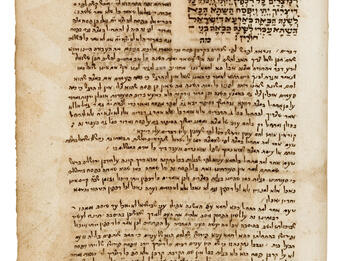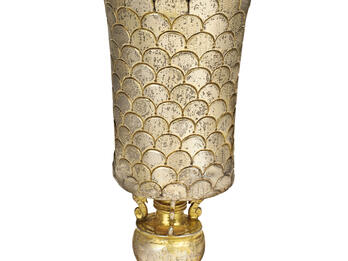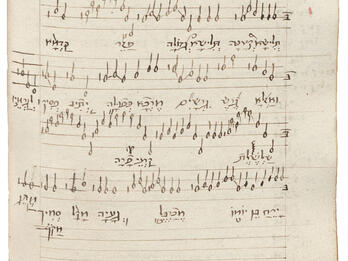Minhage de-kehilah ha-kedoshah Vormaiza (Customs of the Holy Community of Worms): On the Sabbath
Sabbath Customs
27. On the eve of the Sabbath they light the oven in the home of the beadle, where they bake cakes and roast what is required for the Sabbath. They also boil the pots for the needs of the next day. The beadle changes the curtain on the holy ark and the cloth on the reading stand, and the seats of weekdays for the Sabbath seats [ . . . ]. The charity warden brings two wax candles with him to the synagogue at Minḥah [afternoon service] on the eve of the Sabbath, which weigh enough that they will burn throughout the Sabbath, night and day. He lights them right away at Minḥah. The charity warden lights them, places one on the reading stand in front of the cantor, and one on the stand before the Torah scroll, which is set down on a table on the reading stand. Anything left of those two candles at the conclusion of the Sabbath is placed on the candelabrum in front of the ark, to be lit afterward on weekdays during morning and evening services. The charity warden also brings woven candles, corresponding to the number of lamps around the reading stand and in special places in the synagogue, where candelabra are fixed. He places a candle on each one of them, but does not light them; rather, they are left there until the end of the Sabbath, at which point they are lit by the beadle’s lad [ . . . ].
28. Various individuals will bring a woven candle with them to light in honor of the Sabbath. They should light them during the afternoon prayer, after the kedushah [responsive recitation of “Holy, holy, holy”]. [ . . . ]
30. Before Minḥah, the cantor wraps himself in a Sabbath prayer shawl belonging to the congregation and stands at the reading desk to pray. He prays all the Sabbath prayers in that prayer shawl: Shaḥarit [Morning], Minḥah [Afternoon], and Arvit [Evening].
31. The appointed chairman for that month is obligated to provide the Kiddush wine [for the Sabbath blessing]. The goblet for Kiddush and the items for Havdalah are to be brought by the beadle when he enters the synagogue on Sabbath eve for Minḥah. After Kiddush, he will take the Kiddush goblet home with him, but as for the items for Havdalah, that is to say myrtle branch and the [Kiddush] goblet for Havdalah, he should leave them there in the synagogue for the when they are needed at the end of the Sabbath. [ . . . ]
Sabbath Morning Customs
33. On Sabbath morning, the beadle himself—not his lad—calls people to the synagogue in honor of the Sabbath, and the same applies to festival mornings. They recite the blessing for washing hands, Shema‘, and Barukh she-amar [“Blessed be He who said,” the prayer that introduces the psalms recited before the main part of the service], in the special Sabbath melody. It is the custom for two men to sing “Blessed be He who said” together. The first recites until “forever,” the second chants “Blessed be He who redeems and saves, blessed be His Name,” and then the first returns to recite “Blessed are You” until the end of “Blessed be He who said.” [ . . . ]
35. After the Kedushah of the yotser [hymn recited before reciting Shema‘], the beadle goes to the chairman of that month, to his seat in the synagogue, and asks him who will be called up for the Torah reading. The chairman of the month tells him, and the beadle informs the assistant—as most chairmen honor one of their relatives or associates to stand as the assistant, rather than they themselves. If someone has an obligation to be called to the Torah, e.g., one who has the anniversary of a death of his father or mother on the Sabbath, or a ritual circumciser or the godfather of the child, or someone whose wife has come to the synagogue after giving birth, or a bridegroom on the first Sabbath after the prenuptial agreement, or a bridegroom on the first Sabbath after the wedding, or one of the four who must give thanks [for escaping misfortunes], or a mourner who has left the state of mourning, or the chairman of the month on the first Sabbath after his month, or the chairman on the first Sabbath after his election as chairman, or the charity warden after being elected as charity warden, or a bar mitzvah boy, or the rabbi on a day when he gives a sermon before the reading of the Torah, or the rabbi upon finishing the study of a book, or the old rabbi and chairman for the special “good section,”1 with each section recited in its place, or one who comes to live in a house that he owns, which he either bought or inherited, or by any other means, and he has never lived there—all of these are obligated. The beadle informs the chairman of the month those who are obligated, and the chairman is required to call them to the reading. On a day when he cannot call both the godfather and the circumciser, such as on a weekday [when only three men are called to the Torah], the godfather has precedence. People who are ineligible to bear witness [against one another, such as father and son] should not be called one after the other. Some avoid calling them up together at all, even if one or two or more readers separate them. Others maintain that one may call up those who are ineligible to bear witness if they are separated by one other reader. [ . . . ]
Customs of the End of the Sabbath
41. At the end of the Sabbath, close to sunset, the beadle brings with him to the synagogue the goblet and the wine for Havdalah, while the other items for Havdalah are already in the synagogue, as explained above in no. 31. He does not call out in the street for people to come to the synagogue. Rather, the beadle just stands in the inner courtyard in front of the synagogue until it is dark, at which point he calls out from the entrance to the courtyard with the words: “shuln, shuln.”2 Then he turns around and walks to the synagogue via the courtyard. When he reaches the center of the courtyard he again calls out, “shuln, shuln,” like the first time. He subsequently knocks on the door of the synagogue on the east side two or three times, and then the cantor wraps himself in the prayer shawl and starts, “And he, the Merciful,” with the melody of the conclusion of the Sabbath. Afterward, one does not recite To David, blessed (Psalm 144) or To the leader with a melody (Psalm 67). He finishes the prayer and then performs the Havdalah ceremony, as is the custom in all communities, and then the kaddish yatom [mourners’ kaddish] is recited.
42. The beadle’s lad prays a little earlier than everyone else, so that he can separate the Sabbath from the week in the “and You have graced us” passage before the cantor finishes reciting “Bless [the Lord].” When the cantor finishes reciting “Bless [the Lord],” he lights a few candles in front of the cantor, and he lights the woven candles in the candelabra around the reading stand and in special places in the synagogue. Afterward he lights all the candles that are in front of the cantor and he lights and adjusts the nerot temidim [eternal lights].
43. Before the beadle leaves the synagogue, he changes the chairs and the curtain of the holy ark and the cloth on the reading stand from the Sabbath to the weekday ones. [ . . . ]
Notes
[These are specific sections of the Torah reading “sold” separately each year as fundraisers for the congregation.—Trans.]
[Shuln is a Yiddish verb meaning indicating that others should “go to synagogue” or “perform the synagogue act.”—Trans.]
Credits
Published in: The Posen Library of Jewish Culture and Civilization, vol. 5.






